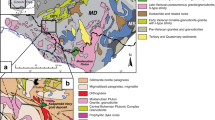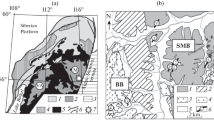Abstract
Precious-metal mineralization in the southern Apuseni Mountains of western Romania is hosted by mid-Miocene (∼14 Ma) andesitic stocks and lava flows. The mineralized veins are surrounded by aureoles of hydrothermal alteration, consisting of quartz, sericite, K-feldspar, pyrite and calcite. The alteration process caused a total homogenization of initial 87Sr/86Sr in the rocks. Ages determined for the hydrothermal alteration are 13.7–15.7 Ma, indicating that hydrothermal alteration immediately followed igneous activity. Furthermore, a large influx of radiogenic Sr took place during alteration, this Sr probably being derived from the hydrothermal leaching of continental meta-sedimentary rocks in the basement.
Similar content being viewed by others
Author information
Authors and Affiliations
Additional information
Received: 5 December 1997 / Accepted: 26 February 1998
Rights and permissions
About this article
Cite this article
Alderton, D., Thirlwall, M. & Baker, J. Hydrothermal alteration associated with gold mineralization in the southern Apuseni Mountains, Romania: preliminary Sr isotopic data. Mineral. Deposita 33, 520–523 (1998). https://doi.org/10.1007/s001260050167
Issue Date:
DOI: https://doi.org/10.1007/s001260050167




